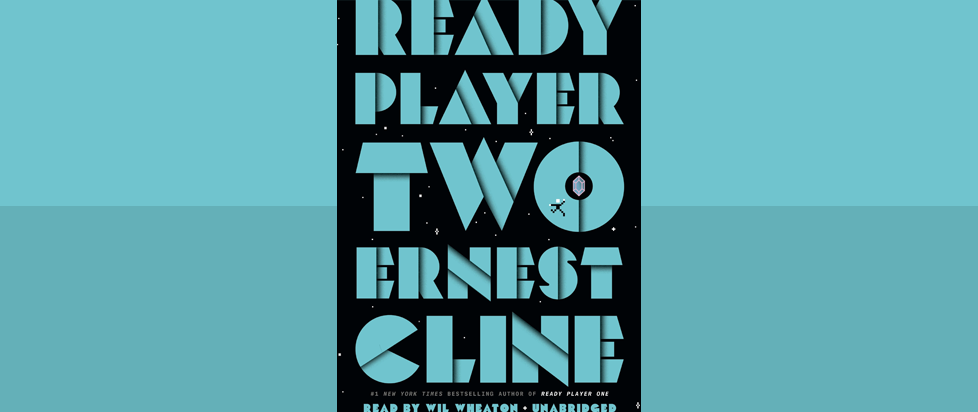
2800 words on Ready Player Two
This has spoilers for both Ready Player One and Ready Player Two. If you are someone who is interested in reading either of those books, then you probably will not enjoy this piece, and you should probably finish both of those books before continuing.
Ready Player One is fine.
It’s not a technically well written book; but it doesn’t have to be. Plenty of books that are simply serviceable are also successful, and by any yardstick, Ready Player One struck all of the marks of commercial acclaim – a NYT bestseller, a Spielberg movie adaptation, a sequel with a “monster” book deal. It’s a nerd-flavored beach read (a subgenre of fiction that is often used derogatorily towards women’s lit but that can be classified as “light, fluffy, or compulsively readable novels that are perfect to take on vacation”). I’ve now listened to the Wil Wheaton voiced audio book 1.5 times.
That is not to say that it’s free of criticism. It’s a novel written with low technical competence, as though someone heard the writer’s adage “show don’t tell” and wildly misunderstood it. There is nothing that could be explained in one sentence that Ernest Cline does not feel like expanding on for a paragraph. It’s prose that isn’t exactly purple, but at least takes on a slight lavender hue, flavored with nostalgia and references instead of the standard flowery adjectives. The characters are one dimensional and fairly static, their world views are frequently reinforced rather than challenged, and every character seems to have a tragic backstory, not because that leads them any direct narrative power but probably because the sources that Cline is pulling from (comics, popular movies, etc) almost always give the heroes a tragic backstory. It’s derivative.
Again, for the most part this is fine. As said by someone in my mentions when I was live-tweeting my second read-through, it’s the equivalent of a “cheesy 2000s action sci fi flick.”
There were less technical criticisms with the first book, targeted at some of the themes and their usages, and these are exceedingly relevant for Ready Player Two. There are three primary criticisms that popped up over and over again when people talked about the first book. Ready Player One is hyper-focused on a specific form of 80’s nostalgia: an Ameri-centric, white, male point of view. This is because the view of that decade that we are getting is from the perspective of one man’s nostalgia (James Halliday), the man who dies and begins the contest that is the focal point of the first and second book. That the self-same nostalgia is that of the author is probably no surprise. This focus is limiting, because it makes it seem like the entire decade is just that (John Hughes movies, classic arcades, and D&D) but it’s understandable when tied to a single character. The second major criticism of the first book is that it has fairly token minority representation, and does not do a great job at representing the members of the ensemble who are not white — one (Aech) is revealed to be a black lesbian woman who was cosplaying as a white man until late in act 3, the other people of color are a pair of Japanese brothers (Shoto and Daito) who seem to spend most of their time talking about honor and bowing. Lastly there was Halliday himself and one of his major characteristics, aside from his love of a long forgotten decade, was an obsession with the dead wife of his best friend. It’s a deeply creepy subplot that informs a lot of his character, and it’s not clear in the first book that Wade Watts (or Ernest Cline by the same token) is aware of how creepy that actually is.
The weirdest thing about Ready Player Two is that it seems to decide to confront these three major criticisms head on; but in probably the least effective way you could imagine. You can kind of see the shape of Ernest Cline’s efforts here, but he does not know how to color that shape in.
Cline takes a solid stab at adding more diversity to his cast of characters in the form of L0hengrin/Skylar. She’s another gunter (the in-universe term for someone who is obsessed with eighties trivia and the scavenger hunts left behind by Halliday) and she’s transgender. Wade admits to having a “mild crush” on her, before finding out that she’s transgender which is where he pats himself on the back for still finding her attractive.
“Her school records included a scan of her birth certificate, which revealed another surprise. She’d been DMAB–designated male at birth. Discovering this minor detail didn’t send me spiraling into a sexual-identity crisis, the way it probably would have when I was younger.”
While this is perhaps a step forward for Cline (Ready Player One included such gems as “Are you a woman. And by that I mean are you a human female who has never had a sex change operation?”) it is basically the same concept, slightly reworded. The idea is that Skylar is not female because she is trans.
Wade follows this by talking about how he reached this new level of empathy and understanding through the use of the ONI–a new version of the OASIS virtual reality headset that allows the user to hook up their brain directly to the virtual world. Users utilizing the ONI headset can also “playback” the memories of other users, giving them the sensory feel of those experiences.
“Thanks to years of surfing the ONI-net, I now knew what it felt like to be all kinds of different people, having all different kinds of sex. I’d experienced sex with women while being another woman, and sex with men as both a woman and a man. I’d done playback as several different flavors of straight and gay and nonbinary sex, just out of pure curiosity, and I’d come away with the same realization that most ONI users came away with: Passion is passion and love was love, regardless of who the participants involved were, or what sort of body they were assigned at birth.“
Wade gets to have his moment of saying “love is love” because he used a fancy VR headset to experience sex in another body and this has given him empathy. This is two-fold a bizarre sentiment because for one, there are currently VR experiences that allow you to “walk a mile” in the shoes of a trans man. But it’s also equally nonsensical because lusting after someone does not make you empathize with them. Literally talk to any trans woman who has been the target of a “chaser” and you’ll understand that.
Without getting into the fact that Wade severely violates Skylar’s privacy to get this information about her gender, this information is both irrelevant to Skylar’s character and honestly, L0hengrin/Skylar is a character that exists basically just so that Wade can have this “woke” moment of still finding her attractive after finding out her gender identity. Her gender identity never comes up again. Her character appears only two more times in the book, despite the excessive time spent on talking about her and sexuality, and while she does ultimately deliver the MacGuffin sword in the final battle, her adventure and journey happens off screen and her part could have been replaced with an item that simply fetched the sword.
Every time Cline talks about sex in this series, it’s always some flavor of terrible; the first time Wade has sex he says “Then we spent the rest of the week sneaking off to make the beast with two backs at every opportunity. Like Depeche Mode we just couldn’t get enough.” The passages where he tries to go out of heteronormativity are somehow much worse. He continues to refer to something called “nonbinary sex,” and as a nonbinary person I legitimately have no idea what he’s referring to. It is vaguely comical that it seems like he’s somehow pandering to a group of people he did not actually talk to. Did these books have a sensitivity read at all, especially when talking about the subjects that Cline doesn’t seem to know anything about but decides to write confidently about anyway? It’s no wonder that these passages seem to be the ones most heavily targeted by the DMCA take-down notices that have been going around.
This doesn’t even get into what happens with Aech and Shoto, the remaining POC characters from the High Five of Ready Player One. They are the only two characters who decide to take their avatar names as their real world names, which in a vacuum would perhaps not be so odd, but in the context of the rest of the book seems like an odd choice. Shoto is given a bit more of a presence than he had in the first book but he has switched out his samurai armor for ninja garb, and he’s married young to help deal with Japan’s underpopulation problem. That’s basically his entire character. Similarly Aech, the story’s only Black character, is first seen in script going to visit Senegal “because her ancestors had come from there” a fact that is never mentioned again or hinted at before, Her main function comes from her knowing about Prince. Aech is the only character who seems to know anything about Prince, in a room full of people who could have literally died over not knowing their eighties trivia; Shoto is even quoted as thinking the chorus to “Little Red Corvette” is, inexplicably, “living correct.”
This gets into the issue of the narrow focus of the white, American, male culture of the eighties, and presenting it as the One True Canon. Cline’s attempt to seemingly fix this in Ready Player Two is to have the focus of the novels’ hunt be Kira — the dead wife of James Hallidays’ best friend, and his obsession — rather than Halliday himself. Kira is white, female and British, but the differences in their tastes are incredibly narrow. Kira’s stated interests are The Princess Bride, The Dark Crystal, Sailor Moon, Doctor Who, Sonic the Hedgehog, Hayao Miyazaki, J.R.R. Tolkien, and Dungeons & Dragons. The plot of the second book follows trying to unlock the Seven Shard’s of the Siren’s Soul, where, roughly, there will be a Shard hidden on a different planet that is relevant to Kira’s interests and life. Of those stated interests, the only ones that come into play are Tolkien and D&D.
Narratively, Cline chooses to have a world that can be effectively only “solved” with the help of a remaining member of the High Five; Samantha/Art@mis for the John Hughes world, Shoto for a world themed around the classic arcade title Ninja Princess, and Aech for the Prince world. In a vacuum, having the POC characters be experts in the media tied to their race could be coincidental, but it doesn’t seem as such in this context.
The themes for most of the worlds are still overwhelmingly white, and for some reason, Cline decided to lampshade this, by having Aech continually point it out. During the John Hughes quest, Aech says “Look at this lily-white hellscape. Is there a single person of color in this entire town?”(it’s a John Hughes movie-verse, there’s probably at least one offensive Asian stereotype in town) and later during the Tolkien quest, “Let me guess, they’re all white, right? White Elves. White Men. And White Dwarves. I bet everyone we encounter on this Tolkien planet is going to be white, right? Except, of course, for the bad guys? The black-skinned Orcs.” The response from Samantha/Art@mis to the John Hughes complaint is to say that there’s a lack of diversity in the “whole of 80’s cinema” and Wade loses his temper and says “We don’t have time for literary criticism right now, Aech, valid though it may be!” But Cline ultimately chose to feature these creators, these worlds. He then, bafflingly, chose to point out that they were incredibly white and lacked diversity. It’s a level of meta commentary that in the hands of a better writer might have meant something, but in Cline’s hands just feels bizarre. It seems to be him saying “well what can you do” but he’s the author. He can do quite a bit. (Cline similarly decides to go meta on his own brand with one of the bad guys of the book exclaiming, “Don’t you kids ever get tired of picking through the wreckage of a past generation’s nostalgia?…The entire OASIS is like one giant graveyard, haunted by the undead pop-culture icons of a bygone era.”)
The themes are also still heavily tied to American pop culture, which is fine, except that Cline went out of his way to establish the character as British. He doesn’t create any of her interests to tie her to British culture at all (arguably Tolkien, but with Tolkien being so foundational to D&D it’s inclusion feels almost accidental). Cline starts the story with a list of references that promise to be something different from the first book (Sailor Moon! Miyazaki! Doctor Who!) and then doesn’t deviate far from the first book. Perhaps, like Halliday, Cline does not understand Kira or her interests.
Cline decides to recast James Halliday, the pseudo-mentor pseudo-aspirational character in the first book, as a villain. But Halliday was always a creep; it just didn’t seem like the writer or the main character realized that before, so making him an antagonist for Ready Player Two is not really an inspired choice. Fleshing out that Halliday was even more of a creep than previously imagined doesn’t really feel like an act of self-awareness, but just makes the whole endeavor far more uncomfortable than it needs to be.
Halliday comes across as a deeply obsessive incel (before even getting into the evil AI version of him) and every time the characters collect a shard, they see another one of Kira’s deeply personal memories and they quickly realize that the goal of assembling them is to assemble an AI version of the woman herself. To get knee deep into spoiler territory, the big finale involves finding out that Halliday, still deeply obsessed with the woman his best friend married, invited Kira to the OASIS offices to show off a piece of Accessibility hardware to help paraplegics. Then he actually scanned her brain without her consent or knowledge in order to make an AI copy that he could convince to love him. But after her death, he resurrects this identical copy of Kira’s consciousness and by forcibly looking through her memories discovers empathy and decides to present this AI consciousness to her husband as a gift he can someday unlock. Kira (or Leucosia as her AI version is referred to) finds this existence – where a man who was obsessed with her made a “bootleg” AI copy of her without her permission – to be a gift. No person on Earth can ever die again, as long as they have bought into the capitalist world of the OASIS, because their consciousnesses can be effectively stored as computer information. This is ultimately the legacy that Cline writes for his creep nerd: “we are witnessing the dawn of the posthuman era. The Singularity by way of simulacra and simulation. One final gift to human civilization from the troubled-but-brilliant mind of James Donovan Halliday.” By being a super big creep, he actually saved the world.
As with the Ready Player One, Ready Player Two is not prepared to reckon with actual consequences to the actions of its main characters or their inspirations, so it doesn’t. Halliday is a “sociopathic” incel, but he was also a genius who saved the world. Wade invades Skylar’s privacy, but while she finds out that he was watching a chat with her friends – she never uncovers the full extent of it, so this behavior is never fully investigated, interrogated or even brought up again. Wade builds a eco-fascist billionaire nuclear powered spaceship so he can escape the problems of Earth with a dozen of his closest friends in comfort while the rest of the population dies (a plan that would not save humanity anyway due to genetic biodiversity) but that’s OK because the spaceship comes in handy for sending the AI out into space to start new life. Even Samantha/Art@mis, who starts the book being so violently opposed to the new OASIS tech of this story, comes around in the end. It’s not even that the characters start the book where they began, if anything, they seem to regress further back in terms of development. There is nothing new to be found here, nothing to be earned or learned.
In nine more years, we may get a Ready Player Three and it will perhaps try to fix the failings of the previous books. One can only hope that Cline grows as a writer in a decade more than his characters grow in the course of 400 pages.
If you are interested, you can buy Ready Player Two from Bookshop. This is an affiliate link.





